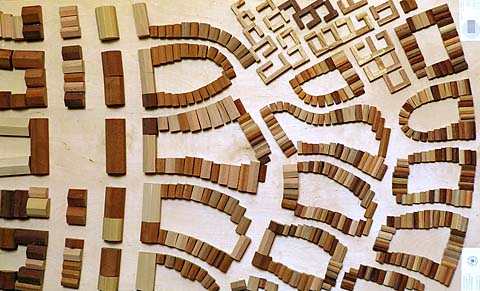  Maquette of a large segment of a car-free neighborhood
Clearly, a significant amount of research is required, but I do not believe that any fundamentally new technology is needed. There are three principal issues that must be addressed before the first shovel of earth is turned. Detailed DesignWhat I have presented here is merely an overview of a design concept. Many details still have to be worked out. Points that need resolution vary widely:
Policy SupportGovernment support is essential, and some legislative changes may be required. The following points need attention.Planning ControlsOne of the goals of the reference design is to create 81 districts, each with its own distinct character. The problem of achieving a distinct character without imposing authoritarian controls is a delicate one. The soundest approach is probably to designate the character of each neighborhood (on the basis of expressed preferences of potential inhabitants) and then establish a community council to implement it. Control over open space development, architectural style, signage, use permits, etc., could be given to a community council. Such a council would have far-reaching powers but would be directly accountable to the residents. Since the size of districts is about 12,000 residents, the possibility exists for very direct democratic administration by the residents.RegulationThe city must have the authority to completely regulate all types of traffic on its streets and to prevent the entry of automobiles. In most jurisdictions, such controls are in the hands of larger political divisions less interested in the resolution of local problems. This needs to change.
The city must also have the authority to regulate the use of the greenbelt surrounding the city. While much or even all of the land could remain in productive use, these uses must be compatible with proximity to a major city. Thus, clear-cutting of forests would be unacceptable for esthetic and ecological reasons, but managed productive forests, accessible for day use, would be a desirable addition. Farmland should remain in farm use, but heavy concentrations of livestock would be phased into field crops, fruit, and vegetables. A mix of uses is highly desirable for the richness and learning opportunities it provides. SpeculationIdeally, the city should own all the land on which development will occur. As the value of this land increases due to the expenditure of public funds to develop infrastructure, the city could recover its investment as land is sold for development. If speculators are permitted to buy this land, they will reap the benefit. Such private gain from public expenditures is not in the public interest. Furthermore, in order to prevent chaotic suburban development at the edges of the city, it would also be necessary for the city to own, or at least regulate, the greenbelt around the city.Land-Grant CitiesThe United States has a long history of making land grants to achieve public policy objectives. The need for affordable housing could be addressed by creating a land-grant city. Those who move to the city could stake a claim to a lot if they agreed to build on it in accordance with the terms of the grant.Reaching Agreement in an Existing CityArriving at an agreement to convert a large part of an existing city to the car-free plan will not be easy. Those attempting to achieve change on such a large scale must proceed carefully and work to obtain wide and deep support for the change. This will take time.At the "Towards Car-Free Cities" conference in Lyon, France, (October 1997) a protocol for achieving change on this scale was developed and is now known as the "Lyon Protocol for the Design and Implementation of Large Car-Free Districts in Existing Cities."
This protocol is an excellent starting point, although much work remains to be done to flesh it out. FundingWho is going to pay for the necessary research & development and the construction of the transportation infrastructure? The first carfree city will probably require government funding, although the possibility remains that a major developer may see the need for car-free cities in Florida and Arizona, to serve the rapidly increasing number of elderly people who can no longer drive safely. |
Back to More
Return Home
About the book: Carfree Cities
E-mail
carfree.com
Copyright ©1996-2002 J.Crawford